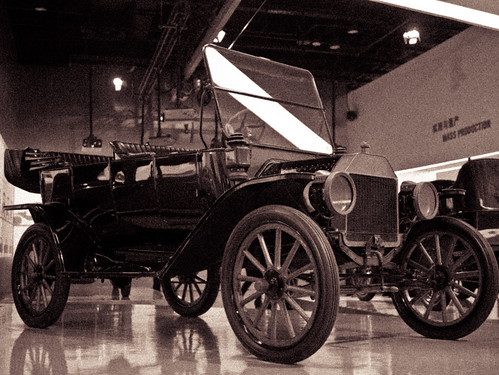
CC | Click on image for license and information.
Cars have long been symbols for personal freedom. With the open road before you you can go anywhere?from behind the wheel you really take control of your destiny. In this regard, cars are empowering. Ownership means that you have the means to be independently mobile, that you own not just a vehicle but choice as well.
Car ads today work to capture these themes of choice, control, and freedom: In a random survey of Men?s Health magazine, the auto spreads on the back pages showed automobiles helping people reconnect with nature (e.g., among sequoias or traversing sandy dunes), or overcoming challenging weather by highlighting their safety features (e.g., handling in icy conditions), or conveying a sense of luxury (e.g., parked, against a minimalist background with emphasis on the shape and gleam of the car) (1).

The Car Without A Single Weakness," The Dorris Motor Car Co. (Laird 798).
Advertising employs the art of persuasion to convince the consumer of need. Prior to 1920, automobile ads featured heavy technical descriptions meant to impress and win over the confidence of the consumer. Purchasing a car was a serious event worthy of serious consideration:
Lengthy copy gave potential owners information calculated to inspire confidence in the machines. It also taught a language for asking questions and exchanging observations that relieved people?s uncertainties about the mysteries under the hood ? Many advertising messages therefore presented cars as machines with parts and prices to be proud of?like the Dorris pictured quiets above a diagram of a ?distillator?? (2).
By the 1920s, as the automobile industry entered its thirtieth year, there was a shift in the emphasis for car ads that allowed for a change in the mechanism of messaging: the proliferation of automobile meant that advertising no longer needed to solely convince consumers to purchase a car, rather it needed to convince consumers to replace their cars, even it it were in working order.

Somewhere West of Laramie," Jordan Motor Car Company, Saturday Evening Post (June 23, 1923). (Laird 808).
It?s at this time the themes of car ownership that we know today begin to emerge. One of the more prominent examples is a feature from the Jordan Motor Company: The owner, Edward S. Jordan leaned toward the use of imagery to drive home messaging. In 1923, the Saturday Evening Post ran an ad, in which Jordan passed over heavy technical copy in favor of images and copy about power, speed and the fun of driving intended to target ?lively, youthful adventurers, or those who perceived themselves as such? (3).
These themes endure because they create a personal connection with the consumer?they marry the driver?s story with the item?s history, extending the concept of need to one that matches a larger social mindset that overlooks the impersonal nature of mass-produced goods. They?re adaptable to the attitudes and inclinations of the times.
For example, this messaging is consistent in many of the top 10 auto ads drawn from the last 25 years identified by The One Club. Chrysler?s 2011 Born of Fire campaign works to craft an intricate story that deeply roots the car in a place. It obscures the mechanics of production in favor of a social connection.
.
The idea of rebirth?both that of Detroit and the automotive industry?works to be a story that consumers can identify with: the recent financial downshifts that have affected many Americans have bred other opportunities for personal rebirth. In this ad, Chrysler?s attempt at a humanized story is intended to integrate the car as naturally as possible into the life story of the consumer.
This social connection is evident in other examples from the The One Club?s list. In Volkswagen?s 1999 Milky Way, the driver and passengers forego a noisy party to drive under a crisp night sky. And Jeep?s 1994 Snow Covered, the vehicle is depicted as so powerful that it can plow through several feel of snow. Honda?s 2004 Cog comes the closest to the first examples of auto ads by illustrating the mechanics of the car using a Rube-Golderg mechanism. Still, the story here is one of control: you have a car that will solidly support your endeavors because everything ?works.?
It?s not that we care less about knowing how things work, or that car ownership is any less a serious endeavor than it was in the late 19th-century. Rather, this shift in marketing represents a shift in our overall relationship to the automobile and recognizes its place in our lives. The automobile doesn?t need to mechanically justify itself. Instead, advertisers work to convince consumers that the automobile can be a partner.
Notes:
(1) Alexander (2003): 550 | (2) Laird (1996): 797 | (3) Laird (1996): 807
Cited:
Alexander, Susan (2003). ?Stylish Hard Bodies: Branded Masculinity in Men?s Health Magazine.??Sociological Perspectives, Vol. 46(4): 535-554
Laird, Pamela Walker (1996).?? ?The Car without a Single Weakness?: Early Automobile Advertising.? Technology and Culture. Vol. 36(4): 796-812.
?
Source: http://rss.sciam.com/click.phdo?i=991535bd99d7558cfde416ec44aac4bc
arizona cardinals Big Bird Adam Greenberg Fall Leaves Jim Lehrer 666 Park Avenue Kara Alongi
No comments:
Post a Comment
Note: Only a member of this blog may post a comment.